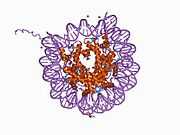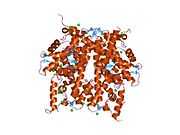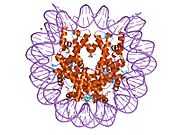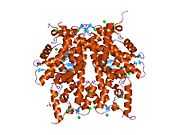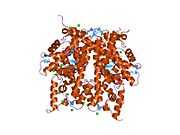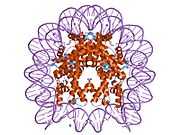H2AFX
H2AFX (H2A histone family, member X) is one of several genes coding for histone H2A. In humans and other eukaryotes, the DNA is wrapped around histone-groups, consisting of core histones H2A, H2B, H3 and H4. Thus, the H2AX contributes to the nucleosome-formation and therefore the structure of DNA.
H2AX becomes phosphorylated on serine 139, then called gamma-H2AX, as a reaction on DNA Double-strand breaks (DSB). The kinases of the PI3-family (Ataxia telangiectasia mutated, ATR and DNA-PKcs) are responsible for this phosphorylation, especially ATM. The modification can happen accidentally during replication fork collapse or in the response to ionizing radiation but also during controlled physiological processes such as V(D)J recombination. Gamma-H2AX is a sensitive target for looking at DSBs in cells. The role of the phosphorylated form of the histone in DNA repair is under discussion but it is known that because of the modification the DNA becomes less condensed, potentially allowing space for the recruitment of proteins necessary during repair of DSBs. Mutagenesis experiments have shown that the modification is necessary for the proper formation of ionizing radiation induced foci in response to double strand breaks, but is not required for the recruitment of proteins to the site of DSBs.
Interactions
H2AX has been shown to interact with MDC1,[1][2] Nibrin,[3] TP53BP1,[4][5][6] Bloom syndrome protein,[4] BRCA1[7][8][9] and BARD1.[7][9]
References
- ↑ Stewart, Grant S; Wang Bin; Bignell Colin R; Taylor A Malcolm R; Elledge Stephen J (Feb 2003). "MDC1 is a mediator of the mammalian DNA damage checkpoint". Nature (England) 421 (6926): 961–6. doi:10.1038/nature01446. ISSN 0028-0836. PMID 12607005.
- ↑ Xu, Xingzhi; Stern David F (Oct 2003). "NFBD1/MDC1 regulates ionizing radiation-induced focus formation by DNA checkpoint signaling and repair factors". FASEB J. (United States) 17 (13): 1842–8. doi:10.1096/fj.03-0310com. PMID 14519663.
- ↑ Kobayashi, Junya; Tauchi Hiroshi; Sakamoto Shuichi; Nakamura Asako; Morishima Ken-ichi; Matsuura Shinya; Kobayashi Toshiko; Tamai Katsuyuki; Tanimoto Keiji; Komatsu Kenshi (Oct 2002). "NBS1 localizes to gamma-H2AX foci through interaction with the FHA/BRCT domain". Curr. Biol. (England) 12 (21): 1846–51. doi:10.1016/S0960-9822(02)01259-9. ISSN 0960-9822. PMID 12419185.
- ↑ 4.0 4.1 Sengupta, Sagar; Robles Ana I, Linke Steven P, Sinogeeva Natasha I, Zhang Ran, Pedeux Remy, Ward Irene M, Celeste Arkady, Nussenzweig André, Chen Junjie, Halazonetis Thanos D, Harris Curtis C (Sep 2004). "Functional interaction between BLM helicase and 53BP1 in a Chk1-mediated pathway during S-phase arrest". J. Cell Biol. (United States) 166 (6): 801–13. doi:10.1083/jcb.200405128. ISSN 0021-9525. PMC 2172115. PMID 15364958.
- ↑ Fernandez-Capetillo, Oscar; Chen Hua-Tang, Celeste Arkady, Ward Irene, Romanienko Peter J, Morales Julio C, Naka Kazuhito, Xia Zhenfang, Camerini-Otero R Daniel, Motoyama Noboru, Carpenter Phillip B, Bonner William M, Chen Junjie, Nussenzweig André (Dec 2002). "DNA damage-induced G2-M checkpoint activation by histone H2AX and 53BP1". Nat. Cell Biol. (England) 4 (12): 993–7. doi:10.1038/ncb884. ISSN 1465-7392. PMID 12447390.
- ↑ Ward, Irene M; Minn Kay; Jorda Katherine G; Chen Junjie (May 2003). "Accumulation of checkpoint protein 53BP1 at DNA breaks involves its binding to phosphorylated histone H2AX". J. Biol. Chem. (United States) 278 (22): 19579–82. doi:10.1074/jbc.C300117200. ISSN 0021-9258. PMID 12697768.
- ↑ 7.0 7.1 Mallery, Donna L; Vandenberg Cassandra J; Hiom Kevin (Dec 2002). "Activation of the E3 ligase function of the BRCA1/BARD1 complex by polyubiquitin chains". EMBO J. (England) 21 (24): 6755–62. doi:10.1093/emboj/cdf691. ISSN 0261-4189. PMC 139111. PMID 12485996.
- ↑ Paull, T T; Rogakou E P; Yamazaki V; Kirchgessner C U; Gellert M; Bonner W M (2000). "A critical role for histone H2AX in recruitment of repair factors to nuclear foci after DNA damage". Curr. Biol. (ENGLAND) 10 (15): 886–95. doi:10.1016/S0960-9822(00)00610-2. ISSN 0960-9822. PMID 10959836.
- ↑ 9.0 9.1 Chen, Angus; Kleiman Frida E; Manley James L; Ouchi Toru; Pan Zhen-Qiang (Jun 2002). "Autoubiquitination of the BRCA1*BARD1 RING ubiquitin ligase". J. Biol. Chem. (United States) 277 (24): 22085–92. doi:10.1074/jbc.M201252200. ISSN 0021-9258. PMID 11927591.
Further reading
- Redon C, Pilch D, Rogakou E et al. (2002). "Histone H2A variants H2AX and H2AZ.". Curr. Opin. Genet. Dev. 12 (2): 162–9. doi:10.1016/S0959-437X(02)00282-4. PMID 11893489.
- Fernandez-Capetillo O, Lee A, Nussenzweig M, Nussenzweig A (2005). "H2AX: the histone guardian of the genome.". DNA Repair (Amst.) 3 (8–9): 959–67. doi:10.1016/j.dnarep.2004.03.024. PMID 15279782.
- Mannironi C, Bonner WM, Hatch CL (1990). "H2A.X. a histone isoprotein with a conserved C-terminal sequence, is encoded by a novel mRNA with both DNA replication type and polyA 3' processing signals". Nucleic Acids Res. 17 (22): 9113–26. doi:10.1093/nar/17.22.9113. PMC 335118. PMID 2587254.
- Banerjee S, Smallwood A, Hultén M (1995). "ATP-dependent reorganization of human sperm nuclear chromatin". J. Cell. Sci. 108 (2): 755–65. PMID 7769017.
- Ivanova VS, Hatch CL, Bonner WM (1994). "Characterization of the human histone H2A.X gene. Comparison of its promoter with other H2A gene promoters". J. Biol. Chem. 269 (39): 24189–94. PMID 7929075.
- Ivanova VS, Zimonjic D, Popescu N, Bonner WM (1994). "Chromosomal localization of the human histone H2A.X gene to 11q23.2-q23.3 by fluorescence in situ hybridization". Hum. Genet. 94 (3): 303–6. doi:10.1007/BF00208289. PMID 8076949.
- Rogakou EP, Pilch DR, Orr AH et al. (1998). "DNA double-stranded breaks induce histone H2AX phosphorylation on serine 139". J. Biol. Chem. 273 (10): 5858–68. doi:10.1074/jbc.273.10.5858. PMID 9488723.
- El Kharroubi A, Piras G, Zensen R, Martin MA (1998). "Transcriptional activation of the integrated chromatin-associated human immunodeficiency virus type 1 promoter". Mol. Cell. Biol. 18 (5): 2535–44. PMC 110633. PMID 9566873.
- Rogakou EP, Boon C, Redon C, Bonner WM (1999). "Megabase chromatin domains involved in DNA double-strand breaks in vivo". J. Cell Biol. 146 (5): 905–16. doi:10.1083/jcb.146.5.905. PMC 2169482. PMID 10477747.
- Rogakou EP, Nieves-Neira W, Boon C et al. (2000). "Initiation of DNA fragmentation during apoptosis induces phosphorylation of H2AX histone at serine 139". J. Biol. Chem. 275 (13): 9390–5. doi:10.1074/jbc.275.13.9390. PMID 10734083.
- Paull TT, Rogakou EP, Yamazaki V et al. (2001). "A critical role for histone H2AX in recruitment of repair factors to nuclear foci after DNA damage". Curr. Biol. 10 (15): 886–95. doi:10.1016/S0960-9822(00)00610-2. PMID 10959836.
- Deng L, de la Fuente C, Fu P et al. (2001). "Acetylation of HIV-1 Tat by CBP/P300 increases transcription of integrated HIV-1 genome and enhances binding to core histones". Virology 277 (2): 278–95. doi:10.1006/viro.2000.0593. PMID 11080476.
- Chen HT, Bhandoola A, Difilippantonio MJ et al. (2000). "Response to RAG-mediated VDJ cleavage by NBS1 and gamma-H2AX". Science 290 (5498): 1962–5. doi:10.1126/science.290.5498.1962. PMID 11110662.
- Chadwick BP, Willard HF (2001). "Histone H2A variants and the inactive X chromosome: identification of a second macroH2A variant". Hum. Mol. Genet. 10 (10): 1101–13. doi:10.1093/hmg/10.10.1101. PMID 11331621.
- Burma S, Chen BP, Murphy M et al. (2001). "ATM phosphorylates histone H2AX in response to DNA double-strand breaks". J. Biol. Chem. 276 (45): 42462–7. doi:10.1074/jbc.C100466200. PMID 11571274.
- Ward IM, Chen J (2002). "Histone H2AX is phosphorylated in an ATR-dependent manner in response to replicational stress". J. Biol. Chem. 276 (51): 47759–62. doi:10.1074/jbc.C100569200. PMID 11673449.
- Deng L, Wang D, de la Fuente C et al. (2001). "Enhancement of the p300 HAT activity by HIV-1 Tat on chromatin DNA". Virology 289 (2): 312–26. doi:10.1006/viro.2001.1129. PMID 11689053.
- Chen A, Kleiman FE, Manley JL et al. (2002). "Autoubiquitination of the BRCA1*BARD1 RING ubiquitin ligase". J. Biol. Chem. 277 (24): 22085–92. doi:10.1074/jbc.M201252200. PMID 11927591.
- Zhu H, Hunter TC, Pan S et al. (2003). "Residue-specific mass signatures for the efficient detection of protein modifications by mass spectrometry". Anal. Chem. 74 (7): 1687–94. doi:10.1021/ac010853p. PMID 12033261.
| |||||||||||||||||||||||||||||||||



